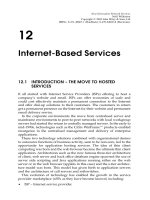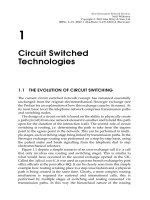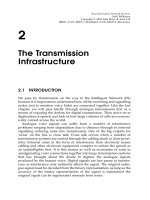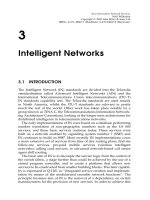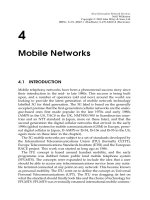Dịch vụ mạng thế hệ kế tiếp P14
Bạn đang xem bản rút gọn của tài liệu. Xem và tải ngay bản đầy đủ của tài liệu tại đây (156.64 KB, 12 trang )
14
Expectation and
Realisation
14.1 TOO MUCH TOO SOON?
The last decade has seen massive acceleration in the introduction of new
technologies and what seemed to be an insatiable demand for IT. Just look
at the changes that we have seen: WAP, GPRS, xDSL, DWDM, VoIP, xSPs
and hosted services, Bluetooth, B2B and B2C, XML, Java, and others. The
thirst for new things has made the market fickle; just look what’s
happened to Wireless Application Protocol (WAP). WAP was/is basically
a good idea with a good foundation just oversold (some might argue
under-delivered?). As the hype fell away and the realisation set in that
WAP over 2G data (9.6 kbps) wasn’t going to set the world on fire, just as
readily as the investment came, the industry and media have nailed the
coffin shut! What’s interesting is, in the Far East NTT DoCoMo’s equiva-
lent service (i-mode) has had a resounding success in this area (in excess
of 24 million subscribers!).
The free lunch syndrome could well have fuelled this demand. The
Internet model seemed to imply you could have services for free and as
Internet Service Providers (ISPs) strove to offer free access numbers,
this vision became even more believable. The issue was that revenues
had to be made somewhere and the search centred on selling advertis-
ing space in portals. Voice seemed to be a no go area even companies
with a massive investment in voice were treating voice as an evil
product and turning their backs on it as quickly as they could to
rush to invest in the Internet bubble. The massive investments (and
greed) with no return soon created a lack of confidence in the market
that unfortunately resulted in collapse of investment and lack of confi-
Next Generation Network Services
Neill Wilkinson
Copyright q 2002 John Wiley & Sons, Ltd
ISBNs: 0-471-48667-1 (Hardback); 0-470-84603-8 (Electronic)
dence that has not only affected the Internet start-ups, but the solid
telecommunications businesses.
Now it’s easy to make these observations in hindsight, it always is, but
what can be learned from this? The lesson is telecommunications takes
time, look back over its long history and you see incredible effort put into
getting things right, without the massive investment in the standardisa-
tion process, we would have still been using operators or connect inter-
national calls, because the different ’phone systems wouldn’t have been
compatible.
I believe the telecoms industry has now learned this lesson and is
concentrating its efforts and finances on structured longer term projects
with structured investment and key measurable deliverables, for example
Hutchison 3G, in the UK, is backed by Hutchison Whampoa, NTT
DoCoMo and KPN. Hutchison 3G are looking to become a major force
in third-generation (3G) mobile telecommunications by building a new
3G infrastructure, unencumbered by having to write off investment in
existing 2- and 2.5G equipment.
This enforced slowdown is good news for everyone; the previous pace
of change could not have been sustained.
14.2 WHERE TO NOW?
The challenge for operators in the telecoms space is clearly to make good
of the convergence of the voice and Internet worlds. In order to continue
to gain revenue from a product with declining margin (voice) two options
present themselves: cut the cost of provision or subsidise the cost from
other products. Voice isn’t going away, people like to talk.
The options are actually both possible with the technologies available to
telecoms network operators. Cost cutting can be made through better,
slicker, provisioning of voice services. The World Wide Web (WWW)
has presented an excellent opportunity to allow customers to order, provi-
sion and control their own services. This combined with open systems,
software frameworks and common Application Programming Interfaces
(APIs) from initiatives such as Operational Support System (OSS) through
Java, Java APIs for Integrated Networks (JAIN), Java 2 Enterprise Edition
(J2EE) and .NET should make it possible to reduce the cost of the process
of acquiring and providing for new customers and will provide the soft-
ware necessary to construct the new componentised services. Next-
generation network softACD and Customer Relationship Management
(CRM) should assist organisations in providing customers with post
sales care and through increased use of customer self-help systems,
drive down cost in this area too. The key message here is about using
the technology to the best end to augment business processes and main-
tain customer satisfaction.
EXPECTATION AND REALISATION176
Subsidisation of dwindling voice margin with more lucrative products
may sound like not such good business practice and may even appear to
be illegal under some licensing conditions. What I’m not talking about
here is the practice of undercutting competition by subsidising a loss
making business, but about the use of voice as a key service pull through.
We’ve already stated voice isn’t going to go away, so capitalise on it. Use
service bundling as a means of attracting revenue from other services.
Think about what makes mobile network operators substantial revenue
(and it’s there part of the basic build, short message services). What’sa
good fixed line equivalent – voicemail is a great value-added service.
Bundling voice and dial-up Internet access together with per-month
subscriptions is creating guaranteed revenue for a number of telcos offer-
ing that service. Service charges are the profit earners, whilst usage costs
will reach the point of pretty much zero return on investment.
Another area of focus is around which of the two orthogonal
approaches: specialisation or diversification to take. Specialisation clearly
has greater risk, as any downturn in the specialist area can create big
problems for a business,
1
but it also carries with it an opportunity to
prosper where specific specialisation is in great demand. Diversification
can create security from areas of downturn, but can also cause solutions
that are being marketed to be too woolly and imprecise. The future tele-
coms marketplace will support both these strategies and will create a
multi-tier multi-facetted market space. Figure 14.1 tries to capture this
idea.
Diversification can be created via packaging of other service provider’s
services and for example, the concept of the virtual Application Service
Provider (vASP) can be realised. Nortel have entered the space of service
provision by offering to take over telecoms operators’ circuit switched
networks and run them for a service charge, whilst also introducing
new packet voice based equipment as part of a migration process. Specia-
lisations are realised lower down the strata as suppliers of specific service
elements, such as voicemail platforms, routers or wholesale (leased)
bandwidth providers.
Specialisation can also be represented by companies divesting parts of
their business to become more focused on what are considered core
competencies, for example Alcatel’s recent announcement to outsource
its consumer products manufacturing capability. A number of telecoms
operators are looking to outsource even their current circuit switched
network infrastructures to focus on service provision, in an aim to
move up the food chain to higher profit margin products.
14.2 WHERE TO NOW?
1
At the time of writing Marconi announced job cuts of the order of 4000 staff across the
UK and the closure of one of their sites. This has been blamed on the downturn, but also on
Marconi’s decision to specialize in telecommunications by getting out of defence
contracts.
177
The infrastructural glue that will allow this service tier-ing is Extensible
Markup Language (XML). At each stratum in the model above XML will be
used to define the service (Web Service Description Language (WSDL)),
interact with the service (Simple Object Access Protocol (SOAP)) and allow
dynamic discovery and service brokering to take place (Universal Defini-
tion Discovery and Integration (UDDI)), whilst IP Data Records (IPDRs)
may well provide billing information (see Chapter 8).
What this market separation also creates is greater opportunity for the
service industries that serve the telecoms market space to find new oppor-
tunities to help telecoms service providers and network operators manage
new relationships with vendors and other application/service providers.
Over the last decade the concept of the carriers’ carrier appeared. A
larger network operator would sell chunks of bandwidth or call minutes
from their international networks to other carriers to provide them with
global inter-connects at less than it would cost to build their own.
The larger telcos who are now carriers’ carriers are in a strong position
to become the future service providers’ service provider by providing
white-label (generic/customisable) services at strata 2 through strata 5
in Figure 14.1.
EXPECTATION AND REALISATION178
Figure 14.1 Market segmentation specialisation vs. diversification
14.3 STRATEGIES FOR MAKING IT HAPPEN
This is where I would like to have been able to give you, the reader, the
path to that elusive ‘killer-app’ of services; alas, if anyone knows it, I am
sure they’re not telling. What I will do is give what I believe as some of the
important aspects of next-generation networks for you to consider within
your own environment. The paragraphs that follow highlight some of the
key points of the book and put them in the context of the business decision
to be made.
Do not think class 5 switches (local exchange features) are the only way
of delivering class 5 features, think softswitches, and be careful not to re-
invent the wheel. Only implement those features that your customers
really need. Softswitches offer much greater flexibility for integration of
other features such as Unified Communications (UC) and presence to
existing Plain Old Telephony Service (POTS) style services.
Look to extend the reach of the network as far out to the customer as
you can to create tie-in for service provision. This is a key point for those
companies looking to capitalise on market changes such as unbundling in
the local loop. If access to the local loop is a business goal, look at perhaps
providing an application on customers’ premises. This might seem coun-
ter to the goal of providing hosted services, but not all aspects of the
service need to be hosted.
Make strategic partnerships with key content vendors and service
providers – for example Hutchison 3G has cut a deal for the streaming
delivery of football matches and a deal with 186k for provision of band-
width.
Look to your Business Support Systems (BSS) and Operational
Support Systems (OSS) and ensure they have the flexibility to accom-
modate and process XML records both for the mediation of XML usage
records, and for the exchange of billing information between organisa-
tions. This will help streamline communications between partners and
reduce cost.
Create products and services that are as flexible as possible and that are
endpoint delivery mechanism independent (i.e. multi-channel capable).
UC is a good example of this. The main functional component of a UC
solution is the in-box. All the other components of a UC solution are about
accessing that in-box, irrespective of the means chosen to reach it, email,
and voice browsing or web access.
Look to Megaco as a transition architecture to move your existing
Public Switched Telephone Network (PSTN) services to a packet switch
network infrastructure, only use it where you believe you can’t live with-
out some of those class 5 features that the supplier of your Megaco MGC
will support or if you need to transition profitable Intelligent Network
(IN) services to a packet switched network (for example you may have
invested heavily in Service Control Points (SCPs) and need to write off the
14.3 STRATEGIES FOR MAKING IT HAPPEN 179


